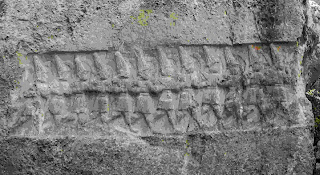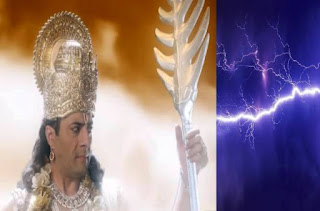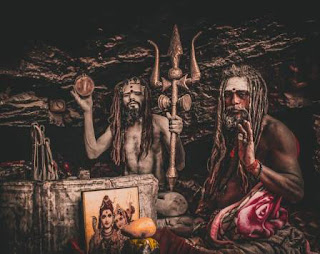According to ancient Hindu scriptures, the number of Gods is 33 crores. Again, somewhere it is innumerable. Many ask why Hindus worship so many gods or how many gods are actually mentioned in Hinduism. In this article, we shall try to find some appropriate answers to some questions often asked by people. Today, with the advent of the internet, we all know that the Vedas refer not to 33 crore deities, but to 33 types of Deities, where the Koti is a Sanskrit term which means Category. But in today's article, we will know this information in a little more detail and try to clarify some ideas about it.
Nirguna Brahman
Most of the deities mentioned in the ancient vedic texts are the names of cosmic and natural powers that have been addressed as deities to reveal their importance. In order to describe what God can actually be, the ancient sages has described him as Nirguna Brahman. Nirguna brahman means one who has no specific virtue, or who is attributeless, i.e. he is neither calm, nor agile. Neither he has the virtue of forgiveness, nor he determines the punishment for a crime. Two opposing qualities are born from this Nirguna Brahman and in the latter case from which Purusha and Prakriti are manifested And the universe is just a reflection of the combinations and evolutions of Purusha and Prakriti which causes infinite numbers of attributions for this Universe. But I am sure that the total algebraic sums of every attribution would be zero if they had numerical values or magnitudes.
And this value of zero defines the Nirguna Brahma. In this way the whole world is expanding from nothingness towards infinity. This is what energy conservation law notes that the total energy of an isolated system remains constant. This says that energy can neither be created nor destroyed; far more, it can only be transformed or transferred from one form to another. That is, the same energy can have many forms and qualities. And it changes its form and quality based on time, medium, environment and objects. For an example it is possible to transmit light energy through a vacuum, but sound energy is unable to travel through a vacuum. In the same way, even though God is one and attributeless, he is endowed with eternal forms and qualities.
Bramha gunas (Supreme fundamental attributes)
Although there is no universal comparison of God with energy, it can be said that combinations of energies and Bramha gunas (Supreme fundamental Attributes) creates life, and this life is just an attempt to discover God, that is, God first transformed into energy and sprinkled into life just to know Himself. Because of this unfulfillment of ‘desire to know’, the universe is constantly expanding with new forms. This Unfulfillment makes the cycle of life and death continuous in the system of nature.
All that exists in this cosmos is the manifestation of an supreme and eternal consciousness, He is the elements of this universe, He is the designer of this universe, on the other hand it is He who is the source of infinite consciousness, again He is the laws and the numbers.
“Aham Bramhasmi – I am the supreme personality”, no other religion has that much guts to accept this truth that every manifestation, of consciousness, in any stages, be it animal, human or any microorganisms is the disclosure of the supreme personality or God.
Now a question may arise in your mind that what are these Bramha Gunas (Supreme fundamental attributes)? And what is their importance in the origin of life?
We can also explain these Brahma Gunas as the basic qualities of the universe. There are 33 types of basic attributions that formed this infinite universe. This infinite universe has been manifested by the different combinations of these 33 fundamental qualities. The ratio of the combinations of these qualities, determines which will be living matter, and which will be inanimate matter in this universe.
Bramha Gunas and Consciousness
Biophysicist Petra Schwille has been working on building a synthetic cell at the Max Planck Institute of Biochemistry in Martinsried, Germany, said “I have always been fascinated by this question, ‘What distinguishes life from non-living matter?’’ According to her, There were around eight key components to create a basic synthetic cell, which are two proteins, three buffering agents, two kinds of fat molecule, and some chemical energy.
Well scientists have been trying to create life artificially in the laboratory for a long time, but with some progress, creating life in a completely artificial way is still just a dream for science. We need to realize that life is a special combination of many things whose design is very varied and complicated. As the organism develops consciousness, the complexity of this life's structure increases. In this universe, both living and non-living things are born on the basis of some basic attributions and through these they maintain their own existence. Birth, old age and death, both living and non-living things go through these three main stages keeping pace with the time dimension. But the difference between living and non-living matter is consciousness. However, the basic elements behind the origin of this consciousness, which is capable to transform an inanimate object into a living thing, is now the subject of research.
Law of conservation of consciousness
Now the question may arise, is it possible to install consciousness in every inanimate object? There is a need to be little clearer about the fact that consciousness is as constant as the amount of energy is in this universe. Consciousness cannot be created or destroyed. Such property of consciousness can be termed as ‘law of conservation of consciousness’ but just as we can use the property of transformation of energy for our own benefits, perhaps in the near future we will be able to control consciousness to some extent. Believe me that the knowledge of controlling consciousness was discovered by ancient Indian sages with the help of strict yogic penance, but unfortunately it has disappeared today due to lack of proper practice and rapid foreign invasions.
Now, coming to the question, is it possible to install consciousness in every inanimate object? Actually no, it is not possible, because the internal or chemical structure of the reservoir or body that is needed to establish consciousness is completely different from the chemical structure of other lifeless objects.
For an example, if we assume of petrol as consciousness and if we assume of a car as an inanimate object, then it is ridiculous to think that if we put petrol in a other lifeless object, let it be a glass, that glass will run like a car. Although both the car and the glass are inanimate or lifeless object, but there are differences in their internal structure.
Brhadaranyaka Upanishad and 33 koti Gods
In Brhadaranyaka Upanishad, while thinking about Brahman, Yajnavalkya is asked how many gods there are. He states that there are three hundred and three thousand and three gods. When Yajnavalkyais repeated his question, he says, thirty-three. When the question was asked again, he says six. Eventually, he says ONE after a few repetitions.
According to above discussed Chapter I, hymn 9, verse 2 of Brhadaranyaka Upanishad, the number 33 emerges from the number of vedic deities described by Yajnavalkya. That are the eight Vasus, the eleven Rudras, the twelve Adityas, Indra and Prajapati.
Now the question is, Are they really God? If no then who are they and what is their role in cosmic activity? And the complexity of philosophy begins with answering this question. We will try to explain them in a very simple way without going into all those complexities, although I will never claim that my idea is justified universal scholars, but I am going try to explain to you what I have understood with my little knowledge and intellect. We have already got an idea of Brahma Gunas. We have seen how this world has been created with all those Brahma Gunas. According to ancient Hindu scriptures, 33 deities controls these 33 Brahma Gunas, or you can say they are the sources of these Supreme fundamental Attributes.
Eight Vasus
The fire (energy), the earth (solid), the air (gaseous), the sky (space), the water (liquid), the moon, the sun, the stars: these are all the Vasus. Everything visible in this universe and even those who maintain the properties of mass and energy transformation, are controlled by the eight Vasu.
The earth gives us the potential of stability, the power of endurance. The wind gives us speed and life force (Prana shakti). Fire gives vigor, holiness, strength, joy. Water is the symbol of life, water is formless and timeless, which gives us the power of determination and which teaches us to be constantly flowing
The sky is eternal, the origin of all things even though it is empty, the eternal sky gives us the ability to be free from binding of all colors and shapes. The moon, sun, stars includes all the chemical elements used to form this universe (among them 118 have been identified as of 2020). On the other hand Sun is the source of life, it represents our souls and the moon represents our mind which again emits the light of sun, while the mind reflects the light of the soul. ( There are some difference between Sun and Star, it will be correct if I say , all suns are stars, but all stars are not stars, for an example , a star can be categorized as ‘sun’ only when it is the center of a solar system. Officially a star can be considered as sun if a significant number of planets and asteroids have been discovered orbiting other stars.)
According to the Acarya Shankara the Vasus are transformed into the bodies and organs of all beings, which operate as an assistance for their work and its fruition, as well as their residing places. They help other beings to survive, and they live on their own. Because they're helping others to live, they 're called Vasus.
Eleven Rudras
The Rig Veda considers the Rudras the deities of the center universe and the atmosphere of star and planet.As they can control the wind, the Rudras represent the breath of life. Throughout the Upanishad Brihadaranyaka, the eleven Rudras are described by ten essential energies (rudra-prana) in the body, and the eleventh by the arrivtman (the soul). The Rudras have been shown to rule over the second stage of creation and the transitional phase of life. They govern the second ritual of sacrifice, the midday offering and the second phase of life, from the 24th to the 68th year of life.
The Chandogya Upanishad recommends that the Rudras be propitiated in case of sickness during this period, and then further states that when they leave the body, they become the origin of tears, implying that the name Rudra is "the one who makes a cry." The Upanishad Brihadaranyaka specifically notes that because the Rudras leave the body – resulting in death – makes people weep, they are Rudras.
The ten Rudras represents ten Pranas (Praana, Apaana, Vyaana, Samaana, Udaana, Naag, Kurma, Krikal, Devadutta and Dhananjaya) are the nerve powers that dwell in the nervous system. The eleventh one represents the spirit of person.
Eleven Rudras have been given different names in various Vedic literatures and Puranas. Although these eleven Rudras possess the form and qualities of God, the proportion of Tama Guna is higher among them, because their character is deadly terrible and fierce. They have the enough power to destroy any demonic and satanic forces. It is impossible for anyone to defeat them in any kind of battle. They are part of Mahakala Shiva himself, so being free from the bondage of time and can control the illusions of time. There is almost no such virtues as compassion, love, compassion and kindness in them, because their purpose is only to destroy the demonic power.
Twelve Adityas
To put it simply, Aditya means we understand Sun. The Vedic literature particularly honor the sons of Aditi, collectively known as Adityas, and are full of hymns addressed to Indra, Agni, Surya, Varun and so forth. The 12 Adityas refer to the 12 solar months and reflect different aspects of social life. In some Purana, these twelve Adityas are also shown as the lords of the 12 Zodiacs constellations. Those are the following:
Ansh (the due proportion),
Ariaman (royalty),
Bhaag (due heritage),
Dhatri (ritual skills),
Tvashtar (the skill of crafting),
Mitra (hospitality),
Pushan / Ravi (success);
Savitra / Parjanya (healing);
Surya / Vivasvan (social legislation),
Varun (destiny),
Vaman (law of cosmology).
Since Buddhism is a branch of Santana Dharma, these 12 Adityas have been adopted by Chinese and Japanese Buddhists as the custodians of Buddhist monasteries. In Buddhism these 12 Adityas are often considered to be the lords of ten directions , Moon and Sun. In Vedic literature, in order to protect these ten directions, who has been collectively called Dash Dikpala. Again in Vedic literature, the protectors of these ten directions are collectively referred to as 'Dasha Dikpala'.
 |
| The twelve gods carved in Yaili Kava cave |
A similar picture can be identified in a rock-cut cave in Yazili Kaya, Turkey! This rock-cave includes numerous images of gods closely related to Hindu and Egyptian deities. The room wall at the bottom of this cave can be found carved with 12 similar gods. These 12 deities are considered t be the Gods of underworld and they belonged to Hittite religion Indra
Indra is the best of the deities and he has been given more responsibility to take care of the Universal systems. Indra, who is also defined as the controller of (all-pervading) electric charge which produces a great deal of force. Electricity is simply described as the electrical charge flow. We may able to realize the essence of Indra’s role, if we can understand the essence of electricity at least a little.
 |
Indra the deity of electricity
|
In today's world we all understand the importance of electricity very well. Everything in this world is made up of innumerable atoms. And the importance of charge behind the formation of these atoms is immense. Electric charge is the physical property of matter which causes it to receive a force when placed in an electromagnetic field. There are two types of electric charge: positive and negative (commonly carried, respectively, by protons and electrons). Charge itself is not energy but energy is found in the field generated by any form of charge. Electricity is all around the Universe, even inside the human body. Our cells specialize in conducting electric currents. For the nervous system, electricity is required to send signals throughout the body and into the brain, allowing us to see, move, feel and think.
Prajapati
In many vedic texts Brahma, the creator god, has been given the name of Prajapati, and often it has been seen that the Prajapati is a professional artist, created by Lord Brahma to help Brahma construct a universe. Prajaapati, also referred the "Yajna" as it supports civilization by purifying air , water, rain and plants, and since it improves the creation of different arts, and in it the honor is conferred on the learned and the wise. The Prajaapati 's value is enormous as it establishes and develops civilization, regulates society with rules , hence he is considered to be the sign of progression of everything.




No comments:
Post a Comment
Please do not enter any spam link in the comment box. Thanks for reading our articles.